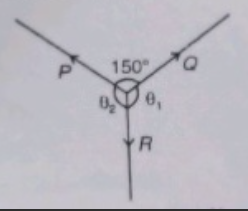Three forces 9,12 and 15N acting at a point are in equilibrium . The angle between 9N and 15N is
cos−1(3/5)
cos−1(4/5)
π−cos−1(3/5)
π−cos−1(4/5)
The correct Answer is:C
To solve the problem of finding the angle between the forces of 9 N and 15 N acting at a point in equilibrium, we can follow these steps:
1. Understanding Equilibrium:
In equilibrium, the vector sum of all forces acting at a point must equal zero. Therefore, if we have three forces →A=9N, →B=12N, and →C=15N, we can write:
→A+→B+→C=0
2. Rearranging the Equation:
Rearranging gives us:
→A+→C=−→B
3. Using the Law of Cosines:
To find the angle θ between →A (9 N) and →C (15 N), we can apply the law of cosines:
|→A+→C|2=|→B|2
Expanding this using the magnitudes and the cosine of the angle:
|→A|2+|→C|2+2|→A||→C|cosθ=|→B|2
4. Substituting the Values:
Substitute the magnitudes:
92+152+2⋅9⋅15cosθ=122
Simplifying gives:
81+225+270cosθ=144
5. Combining Like Terms:
Combine the constants:
306+270cosθ=144
6. Isolating the Cosine Term:
Rearranging to isolate cosθ:
270cosθ=144−306
270cosθ=−162
cosθ=−162270=−35
7. Finding the Angle:
To find θ, we take the inverse cosine:
θ=cos−1(−35)
Since the cosine is negative, we can express this as:
θ=π−cos−1(35)
Final Answer:
The angle between the forces of 9 N and 15 N is:
θ=π−cos−1(35)
In equilibrium, the vector sum of all forces acting at a point must equal zero. Therefore, if we have three forces →A=9N, →B=12N, and →C=15N, we can write:
→A+→B+→C=0
Rearranging gives us:
→A+→C=−→B
To find the angle θ between →A (9 N) and →C (15 N), we can apply the law of cosines:
|→A+→C|2=|→B|2
Expanding this using the magnitudes and the cosine of the angle:
|→A|2+|→C|2+2|→A||→C|cosθ=|→B|2
Substitute the magnitudes:
92+152+2⋅9⋅15cosθ=122
Simplifying gives:
81+225+270cosθ=144
Combine the constants:
306+270cosθ=144
Rearranging to isolate cosθ:
270cosθ=144−306
270cosθ=−162
cosθ=−162270=−35
To find θ, we take the inverse cosine:
θ=cos−1(−35)
Since the cosine is negative, we can express this as:
θ=π−cos−1(35)
The angle between the forces of 9 N and 15 N is:
θ=π−cos−1(35)
Similar Questions
Knowledge Check
Three forces of magnitude 30, 60 and P acting at a point are in equilibrium. If the angle between the first two is 60∘, the value of P is
A30√7B30√3C20√6D25√2Three forces of magnitude 30, 60 and P acting at a point are in equilibrium. If the angle between the first two is 60∘, the value of P is
A30√7B30√3C20√6D25√2Forces of 5N,12N and 13N are equilibrimum. If sin23∘=5/13, the angle between 5N and 13N force is.
A232B67∘C90∘D 113^@
The direction of three forces 1N, 2N and 3N acting at a point,are parallel to the sides of an equilateral triangle taken in order. The magnitude of their resultant is:
View SolutionThe direction of three forces 1N, 2N and 3N acting at a point,are parallel to the sides of an equilateral triangle taken in order. The magnitude of their resultant is:
View SolutionFive equal forces each of 20N are acting at a point in the same plane. If the angles between them are same, the resultant of these forces is
View SolutionWhen three forces of 50N,30Nand15N act on body, then the boy is
View SolutionSix forcees, 9.81 N each, acting at a point are coplaner. If the angles between neighbouring forces are equal, then the resultant is
View Solution

